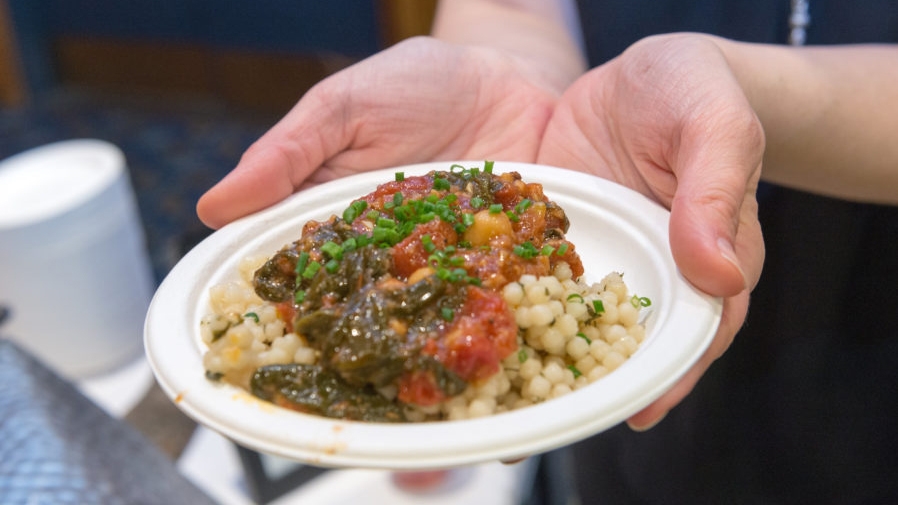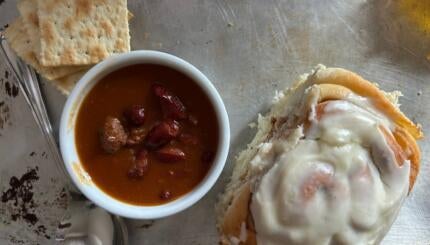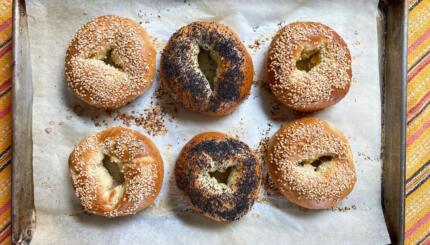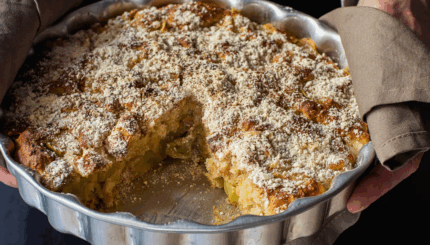Chef Jim Solomon, owner of the Boston restaurant, The Fireplace, likes to stir the pot. The award-winning Jewish chef’s recipe for “Spanish Inquisition Remembered” is a boldly named new twist on a centuries-old Spanish chickpea-based stew known as cocido, that will spice up the Purim menu and the conversation around the Purim dinner table.
Rich in flavor, the cocido is perfect for Purim, a holiday that is filled with masked meaning, charade, and customs and cuisine that reveal more than they appear on the surface. Solomon developed this recipe for Beyond Bubbe’s Kitchen, a Jewish food event that was produced by the Jewish Arts Collaborative, a Boston-based Jewish arts and cultural organization.
The cocido, a common Spanish chickpea-based stew dates back to the 15th century, he found. It’s a simple stew and varied across regions and was also prepared with meat. Solomon was delighted to discover that the dish, often prepared in the winter, was commonly eaten by Jews for Purim.
Non-Jewish Spaniards added pork to the stew. In the time of the Spanish Inquisition, Jews who were hiding their identity were known to have eaten pork to mask their faith, Solomon found.
The Nosher celebrates the traditions and recipes that have brought Jews together for centuries. Donate today to keep The Nosher's stories and recipes accessible to all.
Jewish cooking authority Joan Nathan elaborated on the origins of the Sephardic version of the cocido and its relation to Purim. The long-simmering stew, often cooked overnight in ovens, was a variation of the a cholent known as adafina. It may have included lamb or goat, sometimes barley or bulgur, said Nathan. Christian Spaniards added sausage. “Jews like to think it was Jewish, but everyone ate it,” said Nathan.
“Chickpeas are known as a Purim dish,” Nathan observed. Many believe that in the story retold in The Book of Esther, read on Purim, that Queen Esther ate a vegetarian diet while living in the palace of King Ahasverus in order to follow the rules of kashrut. This led to the custom of eating beans and peas at Purim, she has found.
Solomon’s “Spanish Inquisition Remembered” dish is a garlicky cocido with garbanzo and spinach served over couscous with parsley. The flavorful stew is spiced with smoked and Hungarian paprika, cumin and cayenne. He improvised a paste of toasted Marcona almonds and sour dough bread cubes that adds a robust depth to the flavor-rich stew.
But Solomon had more in mind than creating a mouth-watering contemporary version of the Sephardic stew. “The whole idea for drawing inspiration for a dish from the time of the Inquisition was to be provocative,” he acknowledged. One parallel with Purim was the evil plan of Haman to kill the Jews of ancient Persia, he said. But he also wanted to bring together Purim’s themes of religious persecution, the Inquisition, hidden identities, the Sephardic cocido and today’s political climate.
“I wanted to highlight the similarities to [President] Trump’s intention to ban and expel vast numbers of Muslims and other immigrants,” he explained. “While my dish is a simple, traditional Spanish cocido, it has the hidden meaning of being a political statement about is happening in America today.”
It’s an invitation to a thought-provoking, delicious meal.
Ingredients
10 oz Baby Spinach
¼ cup Vegetable Oil
1/3 cup Garlic
18 oz Chickpeas, drained
18 oz Tomato Filets or Canned Crushed Tomatoes
1/2 cup Marcona Almonds
2 slices Sourdough bread, without Crusts, cut into 1” cubes
1 tsp Ground Hungarian Paprika
1 tsp Heirloom Tomato Powder
1 tsp Cumin
½ tsp Cayenne
1 tsp Smoked Spanish Paprika
Kosher Salt & Pepper to taste
Couscous
2 cups Israeli Couscous
2 ½ cups Water or Vegetable Stock
¼ lb Butter, Unsalted
1 Tbsp Garlic Powder
2 Tbsp Flat Leaf Parsley, chopped
2 Tbsp Kosher Salt
Salt to taste
Directions
Heat 10” skillet over medium to medium high heat.
Add oil and allow to heat for a minute or until the oil gets hot, just before it begins to smoke.
Add garlic and spinach. Cook spinach and garlic until just wilted. Take spinach out of the pan and set aside. Add a bit more vegetable oil and add in sour dough bread cubes and Marcona Almonds. Cook until toasted golden brown. Take out bread and almonds and grind into a paste in a blender or food processor.
Add tomatoes to the same skillet, then the bread almond paste. Cook down for about 15 minutes. Add the spinach and garlic mixture and then the chickpeas, Hungarian paprika, tomato powder, cumin, cayenne, Spanish paprika, and salt & pepper. Cook until thick, about 25 minutes.
Next, make couscous. Heat 2 ½ cups water and butter along with 2 Tbsp kosher salt over high heat. When the water comes to a boil, add in couscous and stir. Reduce heat to medium low – to a simmer. Cook couscous for 6 – 8 minutes, stirring occasionally. When water has evaporated, turn off heat and mix in kosher salt, garlic powder and chopped parsley.
If serving on the same day: remove the sauce and couscous from the heat and enjoy!
If serving the following day: when the spinach chickpea tomato stew is removed from the refrigerator, heat the mixture in a saucepan or skillet. Heat on Medium high heat until desired temperature – about 20 minutes. Re-season the stew as needed. Do not put parsley in couscous if reheating the next day. Heat couscous in a saucepan with ½ cup water and ¼ cup butter and re-season with salt & garlic powder as needed. Before serving, mix in parsley.
Plating: Spoon couscous onto the center of the plate or bowl. Ladle some of the spinach chickpea tomato stew over the top. Sprinkle a little paprika and fresh chives or parsley on top.



